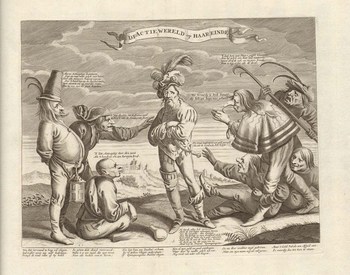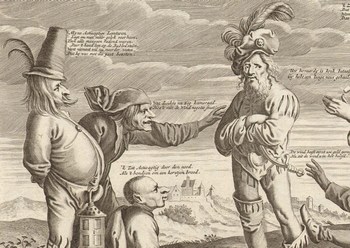This engraved satire on the bubble schemes of 1720 is No. "4" in a series of eight prints of similar character, being Nos. 46 to 53 in vol. i. of "Het Groote Tafereel der Dwaasheid", a collection of Dutch satires on the Mississippi, West India and South Sea Companies of the period..." (Source: Stephens)
|
Speculative bubbles - The First financial crisis.
|
Plates from: Het groote tafereel der
dwaasheid : vertoonende de opkomst, voortgang en ondergang der actie,
bubbel en windnegotie, in Vrankryk, Engeland, en de Nederlanden, gepleegt in den jaare MDCCXX.
The three bubbles--French, British
and Dutch, started at different times but burst at about the same time:
September 1720. |
|
The end of the Stock world |
|
De stervende Bubbel-heer
in den schoot van Madame Compagnie. |
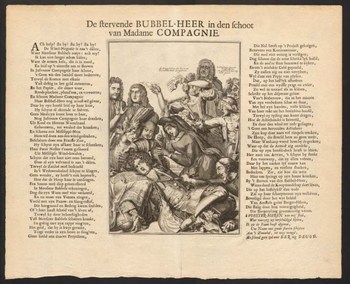
|
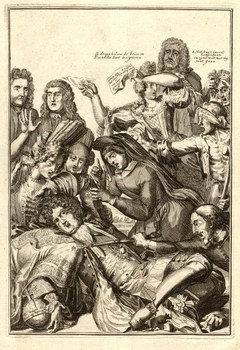 |
||||||
|
A dying John
Law on the floor with his head on the lap of woman, surrounded by group
of figures. Likely etched by Romeijn de Hooghe. The plate was used in
1705 as satire on the Wars of the Spanish Succession under the title "3
Valse, zacht!". With 2 letterpress columns of Dutch verse. |
|||||||
|
The chevalier of the Golden Calf, or captain of the early and late time of slaughtering, in procession to the Oracle of Delphos. |
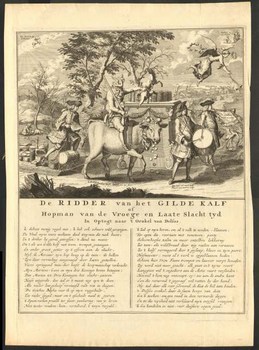 |
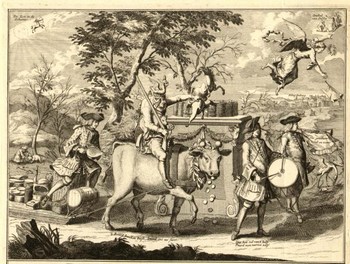
|
||||||||
|
Page taken
from Het groote tafereel der dwaasheid : vertoonende de opkomst,
voortgang en ondergang der actie, bubbel en windnegotie, in Vrankryk,
Engeland, en de Nederlanden, gepleegt in den jaare MDCCXX. Engraved by
Leonard Schenk. |
|||||||||
A satirical map of the Mississippi Bubble: The Island 'Geks-Kop' |
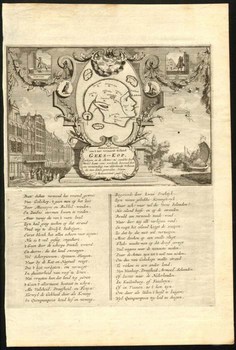 |
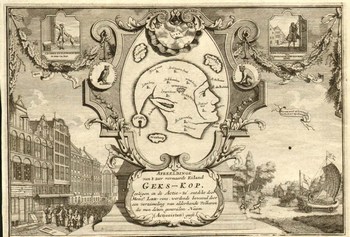
|
||||||||
Afbeeldinge
Van't Zeer Vermaarde Eiland Geks-Kop. Amsterdam, 1720, 290 x 230mm.
Trimmed close to neatline, bottom right corner repaired. |
|||||||||
|
The wind-buyers paid in wind, or those who are last will remain hanging on |
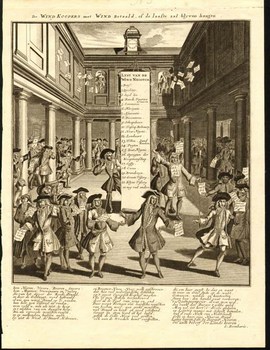 |
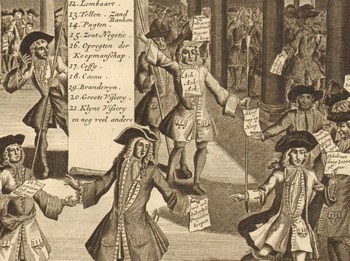
|
||||||||
|
Print
published in : Het groote tafereel der dwaasheid : vertoonende de
opkomst, voortgang en ondergang der actie, bubbel en windnegotie, in
Vrankryk, Engeland, en de Nederlanden, gepleegt in den jaare
MDCCXX.Title in English : "The wind-buyers paid in wind, or those who
are last will remain hanging on." |
|||||||||
|
The bedizened shareholders shown during their honor and influence. |
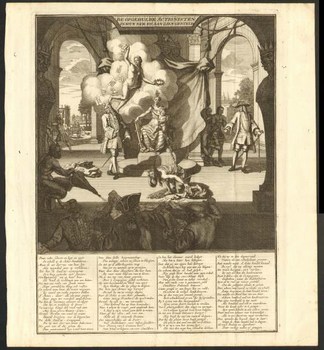
|
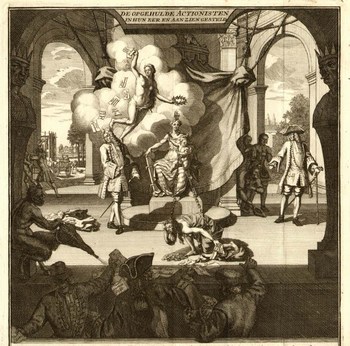
|
||||||||
|
Print
published in : Het groote tafereel der dwaasheid : vertoonende de
opkomst, voortgang en ondergang der actie, bubbel en windnegotie, in
Vrankryk, Engeland, en de Nederlanden, gepleegt in den jaare MDCCXX. |
|||||||||
|
The South Sea Company,
having risen to the top by wind, now laments her loss with a rueful
aspect. |
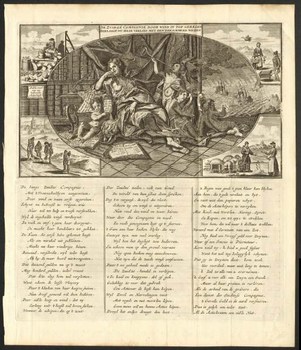 |
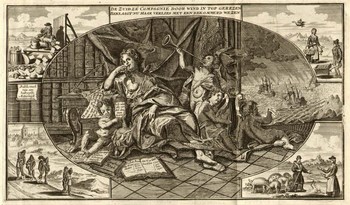
|
||||||||
|
A caricature
in prose and verse satirizing the first truly international speculative
crises in the history of financial capitalism, the "Mississippi scheme"
(1718-1720) of the French Compagnie d'Occident and the speculations its
stock that led to the complete ruin of many of its over-eager French,
Dutch and English shareholders. |
|||||||||
|
The inventor of stock-jobbery in his triumphal car. |
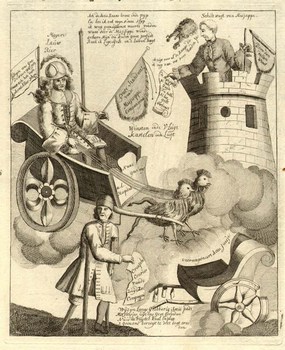 |
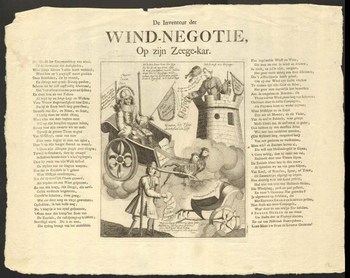
|
||||||||
|
|||||||||
|
True portrait of the renowned Mr. Quinquenpoix |
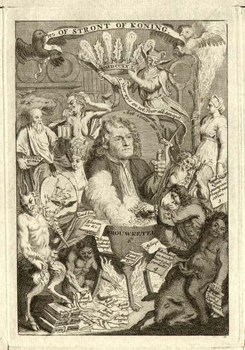 |
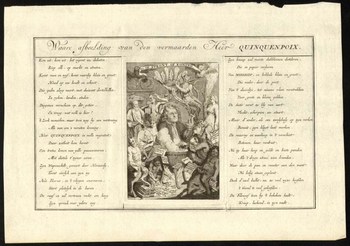
|
||||||||
|
A caricature
in prose and verse satirizing the first truly international speculative
crises in the history of financial capitalism, the "Mississippi scheme"
(1718-1720) of the French Compagnie d'Occident and the speculations its
stock that led to the complete ruin of many of its over-eager French,
Dutch and English shareholders. |
|||||||||
|
Title print of the stock shop or court of Quinquempoix |
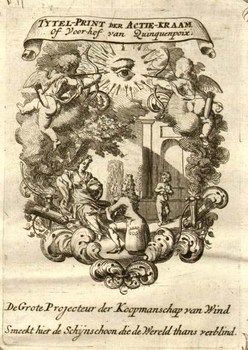 |
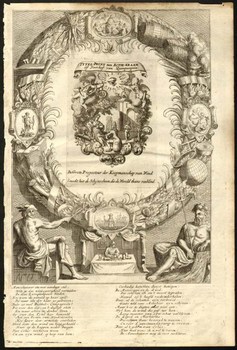
|
||||||||
|
Item
Description : Print published in : Het groote tafereel der dwaasheid :
vertoonende de opkomst, voortgang en ondergang der actie, bubbel en
windnegotie, in Vrankryk, Engeland, en de Nederlanden, gepleegt in den
jaare MDCCXX. |
|||||||||
|
Kermis wind-kraamer en
grossier - La Monopole des Vents. |
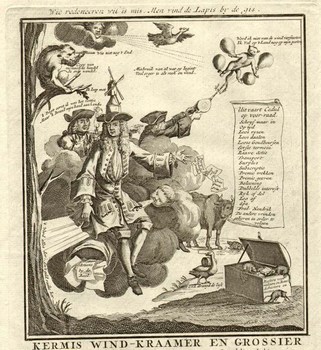 |
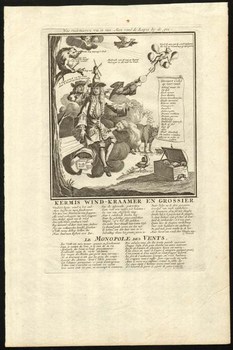
|
||||||||
|
Decorative
print satirizing the stock exchange business after it collapse in the
beginning of the 18th century, that led to the complete ruin of many of
over-eager French, Dutch and English shareholders. Underneath the print
text in Dutch and French.From Great mirror of folly. - Het groote
tafereel der dwaasheid, vertoonende de opkomst, voortgang en ondergang
der actie, bubbel en windnegotie, in Vrankryk, Engeland, en de
Nederlanden, gepleegt in den jaare MDCCXX. An early issue of the
renowned monument for the speculative mania of 1720. 'The great mirror
of folly, showing the rise, progress, and downfall of the bubble in
stocks and windy speculation in France, England, and the Netherlands in
the year 1720' constitute a collection of mostly satirical plates on the
speculations connected with the operations of John Law, together with
the charters of important companies, comedies, poems, etc. Decorative!. |
|||||||||
|
New years gift
. |
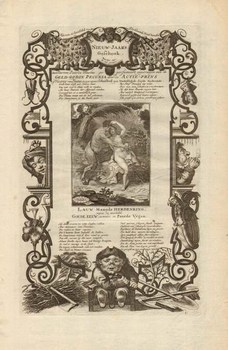 |
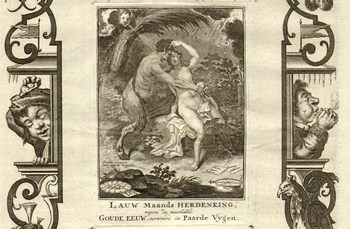
|
||||||||
|
Lauw-Maands
herdenking wegens de nieuwbakke Goude Eeuw vertoverd in Paarde Vygen.Een
Faun (Plutus) omarmt de naakte godin Pecunia door B.Picart. omgeven door
verzen en een rand met bovenschrift: Nieuwjaarsgeschenk, voorts
zinnebeelden en dwergen gelijk als in het Dwergentoneel voorkomen, doch
in geene verzameling gevonden.Deze hoogst belangrijke en geestige
prenten en tekst uit "Tafereel der Dwaasheid" handelende over de
Windhandel van 1720 (o.a. Tulpenhandel). Zeer belangrijke getuigenissen
over de handel uit die tijd. Literatuur: Drugulin, Historische
Bilderatlas/ Fr. Muller: Beredeneerde beschrijving van Ned. Historie
platen en zinneprenten, 1876/ Prof. Laspeyres, Gesch. der
Volkswirtschaftl. Anschauungen der Niederlaender u. ihrer Literat. z.
Zeit der Republik, 1863. |
|||||||||
|
Directrice der Vervalle Actie-Regimenten |
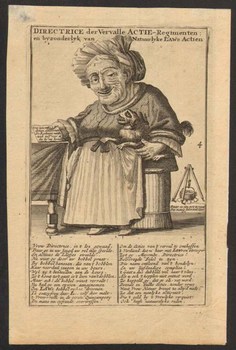 |
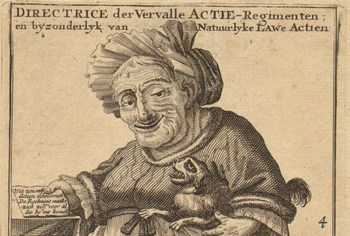
|
||||||
|
|
|||||||
|
Portrait of Madame Law |
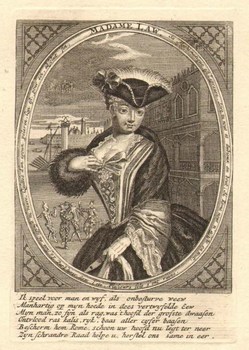 |
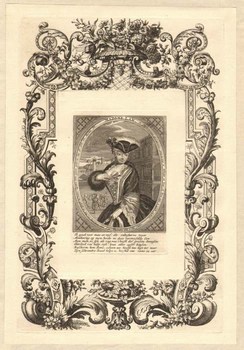
|
||||||||
|
Print
published in : Het groote tafereel der dwaasheid : vertoonende de
opkomst, voortgang en ondergang der actie, bubbel en windnegotie, in
Vrankryk, Engeland, en de Nederlanden, gepleegt in den jaare
MDCCXX.Portrait of Madame Law. Copper engraving set in a decorative
border.A caricature in prose and verse satirizing the first truly
international speculative crisis in the history of financial
capitalism, the "Mississippi scheme" (1718-1720) of the French Compagnie
d'Occident and the speculations its stock that led to the complete ruin
of many of its over-eager French, Dutch and English shareholders.John
Law (1671-1729), the son of an Edinburgh banker and successful financier
who established the "Banque Générale" in France in 1715, founded the
Compagnie de l'Occident for the exploitation of the resources of French
Louisiana after Antoine Crozat had surrendered his charter in 1717.
Law's reputation caused the stock to sell readily, and the organization
soon enlarged the scope of its activities by absorbing other commercial
companies, its name than being changed to the 'Company of the Indies'.
Enormous profits were anticipated...and the increasing demand for its
stock led to wild speculation. The anticipated immense and immediate
profits were not realized, and soon the scheme revealed itself as a
purely speculative venture. |
|||||||||
